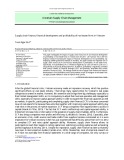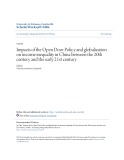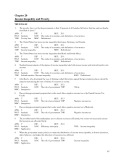
TRƯỜNG ĐẠI HỌC KINH TẾ - ĐẠI HỌC ĐÀ NẴNG
28
FINANCIAL DEVELOPMENT AND INCOME INEQUALITY:
VIETNAM’S EMPIRICAL RESEARCH ON ARDL MODEL
PHÁT TRIỂN TÀI CHÍNH VÀ BẤT BÌNH ĐẲNG PHÂN PHỐI THU NHẬP:
NGHIÊN CỨU THỰC NGHIỆM TRƯỜNG HỢP VIỆT NAM BẰNG MÔ HÌNH ARDL
Ngày nhận bài: 26/09/2024
Ngày nhận bản sửa: 20/02/2025
Ngày chấp nhận đăng: 20/03/2025
Nguyen Ngoc Diep
ABSTRACT
The paper conducts an empirical investigation to examine whether there is a linkage between
financial development and income disparity or not. Final results withdrawn from the ARDL model,
which is employed to deal with Vietnam’s national-level time series data from 1992 to 2021, reveal
that the influence of financial development on income inequality depends on the specific measure
used to capture its multidimensional aspects. On the basis of research findings, the authors would
like to propose some policy implications to Vietnam’s government to take advantages of financial
growth to address unequal distribution in income in Vietnam.
Keywords: ARDL model; Financial development; Income inequality; Multidimensional financial
development; Vietnam.
TÓM TẮT
Bài viết nghiên cứu tác động của phát triển tài chính đến bất bình đẳng phân phối thu nhập tại Việt
Nam, dựa trên số liệu từ năm 1992 đến 2021, được xử lý bằng mô hình tự hồi quy phân phối trễ
(ARDL). Kết quả nghiên cứu cho thấy phát triển tài chính được đo lường dưới nhiều khía cạnh (độ
sâu tài chính, hiệu quả tài chính và ổn định tài chính của các tổ chức tài chính) và mỗi khía cạnh
tác động đến bất bình đẳng phân phối thu nhập theo chiều hướng khác nhau. Từ đó, tác giả đưa
ra một số khuyến nghị cho Chính phủ Việt Nam, tận dụng phát triển tài chính để thu hẹp khoảng
cách thu nhập trong xã hội.
Từ khóa: Mô hình ARDL; Phát triển tài chính; Bất bình đẳng phân phối thu nhập; Phát triển tài
chính; Việt Nam.
1. Introduction
Sustainable development and sustainable
development goals have been calls for urgent
action by all countries in the global partnership
(United Nations, 2015). Vietnam, as an
independent country, has been the 149th
member of the United Nations since 1977 and
has made many important contributions to the
implementation of the United Nations’
missions, including sustainable development.
Besides, being a member country of the
Association of Southeast Asian Nations
(ASEAN), Vietnam has been also determined
to pursue the goals of sustainable development
as the 2030 Agenda for Sustainable
Development of the United Nations is
emphasized in the ASEAN Vision 2025, or in
other words, sustainable development has been
considered the ASEAN’s goal as well.
1
In
addition, having actively participated in the
global economic integration, Vietnam has
already had sixteen effective free trade
agreements (FTAs), including four “new
generation” FTAs such as CPTPP, EVFTA,
UKVFTA, Vietnam - EAEU FTA, to which
sustainable development goals are
Nguyen Ngoc Diep, Thuongmai University
Email: diep.nn@tmu.edu.vn















